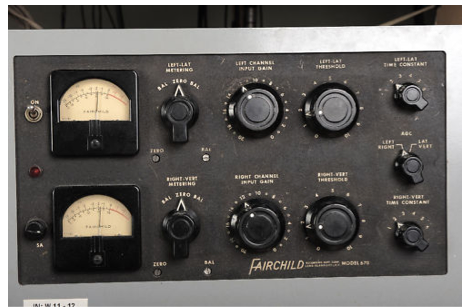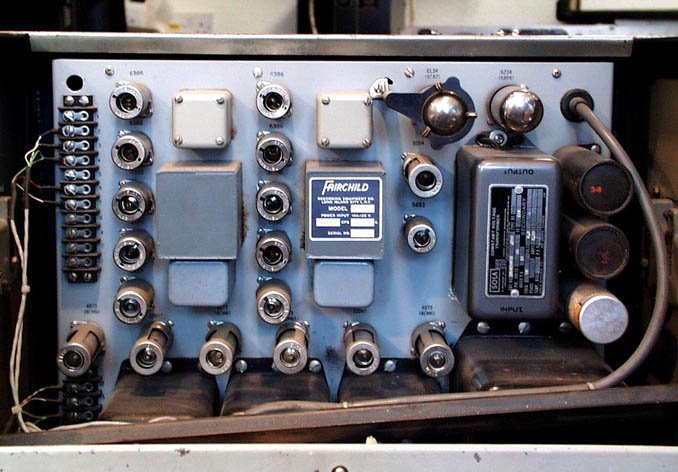With the advent of classic gain reduction units in software/ plugin form, I thought I would start a series of threads explaining how these original classic units worked - kind of a "what makes them tick" series of threads, for those who are using emulations from companies like UAD, T-Racks/IK Multimedia, Waves, Bomb Factory, Steinberg, etc.
I believe that knowing how these original models worked, and what they were/are designed to do, will perhaps help those who are using the plugin versions of them to better understand them, and hopefully, to use them to their optimum.
The first of this series will show information on the Fairchild 670.
This is considered by many to be the "Holy Grail" of compressor/limiters. The 670 can be heard on thousands of hits over the years. In recent years, there has been a resurgence of its use - with both the real model and in plugin form, on "high energy" material and dance mixes.
As the years pass, however, they are becoming much harder to find. Those who have the fortune to have one generally guard it with their lives. For those who wish to own a real one - if you can find one - it can cost you upwards of $40k.
http://www.dreamhir… Dreamhire, an audio equipment rental company in NYC, has one in perfect working order. You can rent it for $235 per day... but unlike many of their other pieces, the 670 has to be delivered (locally to NYC only) and set up by a Dreamhire engineer.
Details:
HISTORY
The original design was created by http://en.wikipedia… Rein Narma
A respected design engineer, Narma had been hired by Les Paul to design and build Paul's first 8-channel mixing console. He developed several early limiter prototypes, eventually deciding on the design of what would eventually become the now-famous 670. This design was then licensed by Sherman Fairchild, who up to that point, had a company who's primary industry was building aircraft. Fairchild decided to create an audio equipment company, and he hired Narma as the company's first chief engineer.
The FAIRCHILD MODEL 670 incorporates two independent limiters on one chassis, which can limit either two independent signals, such as the left and right channels of a stereo signal, or the vertical and lateral components of the same. The latter is accomplished by first bringing the two stereo channels through a matrixing network, dividing them into their vertical and lateral components, limiting them independently, and recombining them through a second matrixing network into left and right channels.
Each half of the MODEL 670 uses only a single push-pull stage of audio amplification and an extremely high control voltage, with the result that the Automatic Gain-Controlled Amplifier never produces any audible or observable thumps. Contrary to most limiting amplifiers previously available, this unit has extremely low distortion and noise under all conditions, both as a straight-through amplifier and under maximum limiting conditions.
The attack time of the unit is made extremely fast in order to catch short transients, and the release time is made adjustable from 0.3 seconds to 25 seconds in six steps. Two of these have release times which are automatic functions of the program material, providing fast recovery for short-duration peaks and an automatic reduction with very long recovery time of overall gain should the program level remain high
Owing to the wide choice of attack and release time, as well as the automatic recovery feature, this unit can be used to limit program material severely without producing the audible thumps or pumping so often associated with limited program material. A remote limiting meter can also be connected to the terminals exposed at the rear of the amplifiers.
The MODEL 670 is designed to be placed into any normal line level circuit and can be set to have a unity gain at no limiting.
FIRST MODERN LIMITER
A radical departure from the classical limiter design, the 670 is characterized by the complete absence of audible thumps, absence of distortion and noise, and it is extremely stable over long periods of time.
4 UNITS IN ONE
The MODEL 670 is either 2 Independent Limiters, or by the flick of a switch, a Vertical-Lateral Component Limiter — all this enclosed within 14 inches of rack space.
INDEPENDENT CONTROL OF VERTICAL & LATERAL AMPLITUDES ON STEREO DISKS
Large vertical amplitudes on STEREO DISKS often produce processing as well as tracking problems. Large vertical amplitudes are produced by random coincidence of out-of-phase components in the two STEREO channels. At the time it was developed and built, the 670 was the only unit in production which could control both components (vertical and lateral) independently, and accomplish this with minimum loss of separation.
EXTREMELY FAST ATTACK TIME
Many a short transient can pass through conventional limiters because of their slowness in attack. The MODEL 670 can produce full limiting effect during the first 10,000ths of a second.
VARIABLE RELEASE TIME
Different program materials require different limiting action. By choosing the correct release time characteristic, even severe limiting can be made to be practically imperceptible. The MODEL 670 supplies six different timing curves, several of them making the release time an automatic function of the amount of limiting used.
LIMITER OR COMPRESSOR
The type of program material - as well as personal preference - dictates the use of either a limiter or a compressor. The 670 can be adjusted to work either as a compressor, (with a ratio of 2 to 1 and a threshold of 5 db below normal program level); or as a peak limiter, (with a compression ratio of 30 to 1 and a threshold of 10 db above normal program level); or it can be adjusted to operate anywhere in-between these two extremes. It can also be used as a straight-through amplifier, with no gain reduction.
Sources: Fairchild, Dreamhire
Comments
Thanks all, for the likes and comments. :) I need to be clear t
Thanks all, for the likes and comments. :)
I need to be clear though, that I didn't write this dissertation based on personal knowledge or experience with the 670 (or 660, either).
I've been in the presence of a real 670 just once in my life, a long time ago, in a galaxy far, far, away, in my younger and early days an AAE.
The article I wrote above is the culmination of my own deep research, using places like Dreamhire and Fairchild as main sources ( and some Wiki).
A lot of it was fairly technical, I just re-worded some of it, not so much that the smart guys here on RO could understand it, but so that I could. :confused: LOL
But, I'm glad that it's proved to be useful to some members here.
To my knowledge, no one here on RO has this "Holy Grail"; and my bet would be that most haven't ever actually used one, either, so I just thought I'd gather data, and post an explanation of this famous and highly sought after limiter, and what made it so "special" at a time in audio history ( and still is special) when audio processing was so limited in availability. There was no Sweetwater, or B&H, or Musician's Friend, or GC ( nor Dreamhire, either) that they could just call up and order one of a plethora of different audio processing devices that would suit their needs. Most of what we consider to be "classic" now was all designed and built out of necessity by audio engineers - those who faced a certain obstacle, and needed a particular device to accomplish a certain task.
I still wince occasionally, when I refer to myself as an "audio engineer", knowing that the REAL engineers were cats like Bill Putnam, Dave Gold, Stan Ross, Wally Heider, Tom Dowd, Ken Smith, Geoff Emerick, and so many others who were knowledgeable and skilled enough to actually design and build those now-classic processors. Those cats were true audio engineers.
I think we have a handful of guys like that here on RO - Boswell, Joel, Marco ( Boswell , Gette , pcrecord... and others, too), who have actually built audio gear ....
( and regardless of any personal feelings about her, back when Remy was still a member here, I think she had her own fair share of technical chops and accomplishments, too)...
The one thing I do know - for a fact - is that I'm not one of these people. LOL :notworthy:
Yeah, I know which end of a soldering iron is hot - LOL - but I don't have the skill and knowledge as these people I've mentioned above do.
( And even if I did have the knowledge and skill, I don't have the hands - or the eyes - anymore, to do fragile/detailed component assembly)
Anyway, I'm glad this post is still seeing some action, and that members are finding it interesting and useful.
Enjoy. :)
-d.







Great article Donny, thank you.
Great article Donny, thank you.